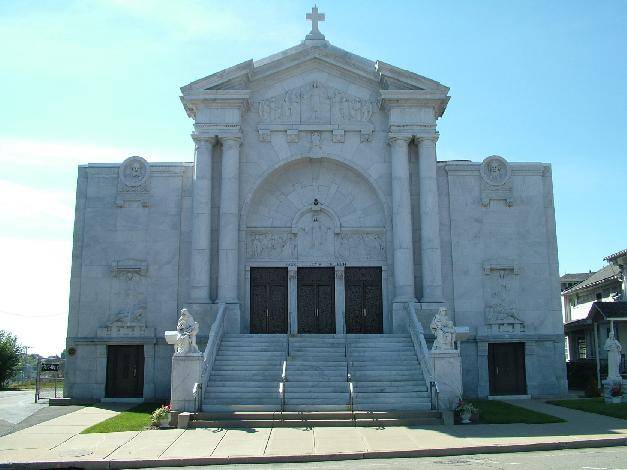The Shining Stone of West Scranton
Two soldiers lay dying. The Italian soldier beseeches Jesus Christ to take his soul to Heaven while the war rages on behind him. To his left, an American soldier prays the same prayer to the Blessed Mother.
Brothers in arms, now brothers in marble.
Every day for the past 85 years, the sun rises and sets on the faces of these two men, etched in time on the front of St. Lucy’s Parish, the Mother Italian Church of the Diocese of Scranton, Pa.
“The history of this parish is really unique,” said Rev. Sam Ferretti, the pastor of St. Lucy’s Parish. “When it was built, this was still basically an immigrant parish with a lot of family members in Italy, and both Italy and the United States were allies in World War I. The parish was dramatically impacted by the war because they were getting death notices here and as well as for relatives in Italy.”
St. Lucy’s is believed to be the first Italian parish in the Diocese of Scranton; formally established in 1891 by Rev. Rosario Nasco, although it can trace its origins back to 1871. Scranton was a major hub of European immigration during the late 1800s and early 1900s because of the prominence of its coal mining industry. Ethnic groups would establish their own parishes and hold services in their native languages. Today, however, ethnic designations of parishes in the Diocese of Scranton refer to the church’s cultural heritage.
“There is no true ethnic parish anymore in this area because we don’t have the immigration anymore of the original ethnic groups and because of intermarriage. The numbers of Italians immigrating into this area is practically non-existent. Because St. Lucy’s started off as an Italian parish it is known as an Italian parish,” Fr. Ferretti said.
Although the shine of the marble exterior of St. Lucy’s is as bright as the lights of the city of Naples, from where most parishioners can trace their ancestry, the interior of the church also harkens back to the madre patria.
As Fr. Ferretti walks down the main aisle of St. Lucy’s, he pauses a moment to talk about the imposing stained glass windows on either side of the church. He points to the windows on the right, which depict various prophets of the Old Testament, except for one of the heroine Judith, who is hardly ever portrayed in stained glass, and says, “Look very carefully at their faces and hands.”
Fr. Ferretti explained that the windows came from Munich, Germany and were executed under the guidance of F.X. Zettler, a master artisan known for injecting humanity into his glass portraits. “You can actually see the lines on their faces and hands,” Fr. Ferretti said.
“But, when Mussolini came into power, this was an anti-fascist parish. On June 10, 1931, the local fascists bombed the opposite side of the church; blowing out the original windows. They were replaced after the war ended in 1947, but if you look carefully at the faces and hands of our patron saints, you can see that the quality is different,” Fr. Ferretti said. “After World War II, the top paid artists, who did the faces and hands, were gone. They are still Zettler windows but not the original quality.”
Other parts of St. Lucy’s Church have undergone a more pronounced metamorphosis since construction was completed in 1924.
“Unfortunately in the mid 1950s, the mines collapsed underneath the bell tower and, due to bad advice, the church underwent many changes that it didn’t have to,” Fr. Ferretti said, adding that the pastor at the time was told that the church was too heavy and would collapse into a coal mine if most of the marble was not removed from the interior.
“There used to be a marble walk up pulpit that today would be valued between $300,000- $500,000. The bottom of this pulpit had three angels holding a rose garland and the top showed Christ entering Jerusalem with a crowd all around him,” Fr. Ferretti added. “But now the base is outside at St. Ann’s [The Basilica of the National Shrine of St. Ann, also located in Scranton] and the pieces of the pulpit are in someone’s yard, eaten away by decades of acid rain. We offered to buy the pieces but the owners wouldn’t sell.”
Other interior changes included the removal of a marble depiction of Christ’s crucifixion above the main altar and the removal of the church’s original marble flooring.
“This church cost millions in 1927; the cost of it today would be well over ten million dollars,” Fr. Ferretti said. “You can tell the subtle differences in the marble angels around the altar because they are hand-carved. You don’t get that quality anymore.”
One original artifact in St. Lucy’s remained a mystery until Fr. Ferretti became pastor several years ago. To the left of the main entrance was an unmarked statue that he has since identified.
“It took me eight months of searching through books of pictures of saints before I finally identified this statue as Sant’Agnello, one of the co-patrons of Naples,” Fr. Ferretti said. “We don’t know which group brought this statue here but you could tell it is the original because it is burlap with a plaster coating so it would be easier to carry in the processions instead of the solid heavy plaster ones we make.”
“There are glimpses of our past all over this church, not just our Italian heritage, but our local heritage as well, Fr. Ferretti said.
While exiting St. Lucy’s Church, visitors can see a Latin inscription around the choir loft that translates to, “Awesome is this shrine! It is nothing else but the abode of God and the gateway to Heaven!”
As the sun shines off of the church’s white marble façade, it becomes quite clear that, perhaps, St. Lucy’s church is one of Scranton’s most treasured gateways to Heaven.





































i-Italy
Facebook
Google+
This work may not be reproduced, in whole or in part, without prior written permission.
Questo lavoro non può essere riprodotto, in tutto o in parte, senza permesso scritto.